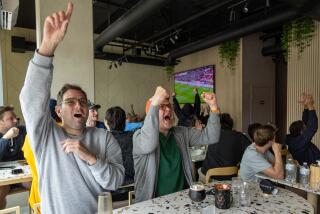DEADLY GAME : England’s Soccer Tragedy: The Day the Front Row Became Death Row
LIVERPOOL, England — Of all the one-liners for which Bill Shankly, the messiah of Liverpool soccer, was renowned, perhaps the best remembered is his version of an old sports witticism: “Football isn’t a matter of life and death. It’s more important than that.”
Shankly died in 1981, after building the Liverpool Football Club from a minor league also-ran into a powerhouse of the British and European game. But his name is now back on thousands of Liverpool lips as residents of this grief-stricken and much-maligned city are forced for the second time in less than four years to wonder if the gods are somehow testing them against their late hero’s yardstick.
Ninety-five Liverpool supporters, most of them residents of this faded, central England port city, were asphyxiated or crushed to death at a semifinal national championship match at Hillsborough Stadium in nearby Sheffield last weekend when surging crowds trampled or trapped them against metal barriers on an enclosed and already overcrowded viewing terrace.
It was the worst sporting disaster in British history and a shock for the nation, but a particularly painful trauma here.
“Our city again has to show its resilience to yet more pain and suffering,” Rev. Ray Hutchinson told more than 500 mourners in nearby Waterloon Thursday as Gary Church, 19, was laid to rest in the first funeral from the tragedy.
It’s so painful because for at least a generation, most of this city has shared Shankly’s obsession with the game. It has been one source of pride in a city and a life style that have for too long been lacking in other satisfactions.
And even as Liverpool suffers the aftermath of its latest soccer tragedy, it is simultaneously demonstrating once more that the game is a powerful glue that can unite its residents in a way remarkable for a community its size.
For the last five days, police estimate, more than 300,000 people have filed into the city’s Anfield football grounds in an extraordinary collective act of pilgrimage. That is the equivalent of nearly 75% of Liverpool’s population. Club officials said their unplanned 10- to 12-hour daily open house will continue at least through the rest of the week.
The mourners have filled cash barrels with donations for bereaved relatives and covered Anfield’s goal posts, perimeter fencing, part of the stands and a sizable portion of the playing field with tributes to the dead.
There are scarfs in Liverpool red and white, as well as the colors of competing teams; stuffed bears and other mementos; soccer balls; original poems, and flowers--a ton and a half of flowers, according to one volunteer steward.
Most of the tributes have been laid at “the Kop”--the standing-room-only section at the home team’s end of the field. The name is taken from a South African hill defended by a Liverpool regiment in the Boer War at the turn of the century.
Anfield has long been known as “the cathedral of English soccer,” in cliched respect for both the success of the Liverpool club and the passion of its supporters. But this week, London Times correspondent Simon Barnes noted, “they turned it into a real cathedral, and the goal at the Kop end became a high altar.”
The second-ranking Anglican clergyman here, Rt. Rev. Michael Henshall, commented: “The tributes (at Anfield) said that the dead had ‘Gone to be with Shank,’ not ‘Gone to be with Christ.’ ”
At Gary Church’s funeral Thursday, they played the Liverpool club anthem--”You’ll Never Walk Alone.”
But the message at Anfield that seemed best to capture the mood of Liverpool read simply: “Why? Why? Why? Why?”
Liverpool fans were also involved in perhaps the blackest page of soccer’s recent, violent history. They triggered a riot in 1985 that claimed 38 lives at Brussels’ Heysel Stadium. Many Continental commentators were quick to link the two tragedies.
Jacques George, president of the European Football Union, criticized what he characterized as the “especially aggressive mentality” of Liverpudlians after Saturday’s disaster at Hillsborough Stadium.
“Once again it’s England; once again it’s Liverpool; once again it’s a demonstration of what I would call savagery,” the French official said in an interview with a Paris radio station. “When you saw the faces of people who were in that gangway in Sheffield, they looked like uncaged animals, their eyes popping out. It was frightening.”
George later apologized for his remarks.
An Italian newspaper, Gazzetta Sportiva, saw last weekend’s tragedy as retribution for Heysel, in which most of the victims were supporters of Turin’s Juventus club.
“We are facing the triumph of stupidity in a country marked by terrible soccer violence, but incapable of learning from it,” the paper editorialized. “Through a sort of tragic revenge, the price has been paid by Liverpool fans.”
Even in Britain, the chairman of the South Yorkshire County Police Federation, Paul Middup, said Tuesday there was “mass drunkenness” among the Liverpool fans whose last-minute surge into Hillsborough was a key contributor to the tragedy.
Other published reports in the central British press, unconfirmed and attributed only to unnamed policemen, charged that Liverpool supporters looted bodies of the dead, and kicked, punched, and urinated on officers trying to revive the injured.
Although the shame of Brussels still runs deep here, Liverpool’s detractors “took two separate incidents that had nothing to do with each other and put them together,” complained Paul Brown, 34, a volunteer Anfield steward.
“We have to live with that, don’t we?” added Brian Christopher, 46, another volunteer who attended his first Anfield game 37 years ago.
Wrote Liverpool Echo columnist Joe Holmes earlier this week:
“Politicians, employers, statisticians, economists, national newspaper editors, TV program producers, and comedians have all fed on us and have been putting us down for years. To all of these we say: Leave Liverpool alone. Let us grieve with our families, our neighbors, our friends and work mates. We do not need you muscling in on our mourning. To each and every one of those people making wild accusations we say: Pipe down. . . . let us pick up the pieces of this tragedy.”
The reaction here reflects a deep sense of separateness--and, some say, inferiority--that Liverpudlians feel toward much of the world outside their own familiar corner of Britain along the Mersey River. A London journalist called this “the only truly foreign city in England.”
Liverpool is economically depressed, left well behind in Britain’s economic turnaround. Merseyside unemployment hovers around 20%. The docks, which once employed about 25,000 workers handling a significant percentage of Britain’s overseas trade, now provide jobs for only about 2,000.
The population here plummeted by about one-third in a generation.
Rev. Henshall characterizes those who are left as “a volatile population in search of an identity. And they can’t find an identity in the normal channels of normal work.”
Football fills the void.
“The one success story in the city has been Liverpool Football Club,” said Chief Executive Peter Robinson.
Liverpool and, to a slightly lesser extent, the city’s other professional soccer team, Everton, “helped it keep its self-respect,” said editor Chris Oakley of the Liverpool Echo. “It would have been very easy to wallow in despair.”
Liverpudlians are weaned on football, and the extent to which its teams and the life of the community are interwoven is probably unrivaled in American experience.
Some supporters concede that the fanaticism with which so many identify with their team can be frightening.
A middle-aged taxi driver said he has refused for the last three years to attend a game if he has to stand in the Kop or the terraces of some other fields.
“It’s too dangerous,” he said. “Years ago, I would have done anything I had to to watch Liverpool from any vantage point whatsoever. But I tend to weigh things up more carefully now before I jump in.”
Liverpudlians concede that there are some people who go to games looking for trouble. But they insist that these are a tiny minority. For the rest, what often looks to opponents and outsiders like dangerous fanaticism among Liverpool supporters is an acceptable, if not laudable, norm.
“Getting pushed and jostled is part of the atmosphere,” said student Steven Collins, 19, with a shrug.
Peter Garrett, co-founder of the Football Supporters Assn., compares the rowdy behavior and bawdy chants of the typical crowd to a war dance.
“It’s a tribal syndrome,” he said.
Even Rev. Henshall, who worries that local football fans have gone “over the top” in their enthusiasm, added quickly that the game nevertheless provides “the most enormous safety valve” for a society that has few other outlets.
If anything, last weekend’s Hillsborough disaster seems destined only to reinforce the game as what Henshall called a folk religion.
A number of families have already asked for permission to scatter the ashes of loved ones killed at the Anfield ground.
A club official responded: “There is no doubt that if this is what the families wish, this is what will happen.”
It wouldn’t be the first time. Bill Shankly’s ashes were also sprinkled over Anfield.






